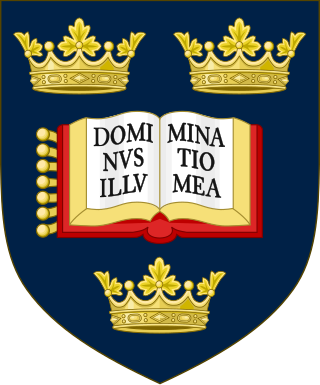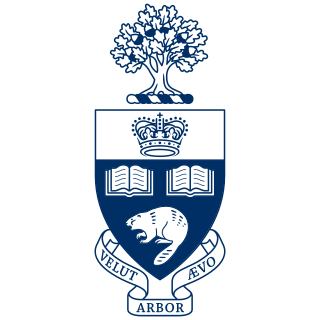
A college is an educational institution or a constituent part of one. A college may be a degree-awarding tertiary educational institution, a part of a collegiate or federal university, an institution offering vocational education, a further education institution, or a secondary school.

Columbia University, officially Columbia University in the City of New York, is a private Ivy League research university in New York City, United States. Established in 1754 as King's College on the grounds of Trinity Church in Manhattan, it is the oldest institution of higher education in New York and the fifth-oldest in the United States.

Dartmouth College is a private Ivy League research university in Hanover, New Hampshire. Established in 1769 by Eleazar Wheelock, Dartmouth is one of the nine colonial colleges chartered before the American Revolution. Emerging into national prominence at the turn of the 20th century, Dartmouth had been considered among the most prestigious undergraduate colleges in the United States during the early 1900s.

The Ivy League is an American collegiate athletic conference, comprising eight private research universities in the Northeastern United States. The term Ivy League is typically used outside sports to refer to the eight schools as a group of elite colleges with connotations of academic excellence, selectivity in admissions, and social elitism. Its members are Brown University, Columbia University, Cornell University, Dartmouth College, Harvard University, Princeton University, University of Pennsylvania, and Yale University. The conference headquarters are in Princeton, New Jersey.

Princeton University is a private Ivy League research university in Princeton, New Jersey. Founded in 1746 in Elizabeth as the College of New Jersey, Princeton is the fourth-oldest institution of higher education in the United States and one of the nine colonial colleges chartered before the American Revolution. The institution moved to Newark in 1747, and then to its current campus, nine years later. It officially became a university in 1896 and was subsequently renamed Princeton University.

Texas A&M University is a public, land-grant, research university in College Station, Texas. It was founded in 1876 and became the flagship institution of the Texas A&M University System in 1948. Since 2021, Texas A&M has enrolled the largest student body in the United States, and is the only university in Texas to hold simultaneous designations as a land-, sea-, and space-grant institution. It is classified among "R1: Doctoral Universities – Very high research activity" and a member of the Association of American Universities.

The University of Pennsylvania is a private Ivy League research university in Philadelphia, Pennsylvania, U.S. It is one of nine colonial colleges and was chartered prior to the U.S. Declaration of Independence when Benjamin Franklin, the university's founder and first president, advocated for an educational institution that trained leaders in academia, commerce, and public service. Penn identifies as the fourth oldest institution of higher education in the United States, though this representation is challenged by other universities, as Franklin first convened the board of trustees in 1749, arguably making it the fifth oldest institution of higher education in the U.S.

The University of Oxford is a collegiate research university in Oxford, England. There is evidence of teaching as early as 1096, making it the oldest university in the English-speaking world and the world's second-oldest university in continuous operation. It grew rapidly from 1167, when Henry II banned English students from attending the University of Paris. After disputes between students and Oxford townsfolk in 1209, some academics fled north-east to Cambridge where they established what became the University of Cambridge. The two English ancient universities share many common features and are jointly referred to as Oxbridge.

Yale University is a private Ivy League research university in New Haven, Connecticut. Founded in 1701, Yale is the third-oldest institution of higher education in the United States, and one of the nine colonial colleges chartered before the American Revolution.
University College London, which operates as UCL, is a public research university in London, England. It is a member institution of the federal University of London, and is the second-largest university in the United Kingdom by total enrolment and the largest by postgraduate enrolment.

The National Collegiate Athletic Association (NCAA) is a nonprofit organization that regulates student athletics among about 1,100 schools in the United States, and one in Canada. It also organizes the athletic programs of colleges and helps over 500,000 college student athletes who compete annually in college sports. The organization is headquartered in Indianapolis, Indiana.

Imperial College London is a public research university in London, England. Its history began with Prince Albert, consort of Queen Victoria, who developed his vision for a cultural area that included the Royal Albert Hall, the Victoria and Albert Museum, the Natural History Museum and several royal colleges. In 1907, Imperial College London was established by royal charter unifying the Royal College of Science, the Royal School of Mines and the City and Guilds of London Institute. In 1988, the Imperial College School of Medicine was formed by merging with St Mary's Hospital Medical School. In 2004, Queen Elizabeth II opened the Imperial College Business School.

In the United States, the Electoral College is the group of presidential electors that is formed every four years for the sole purpose of voting for the president and vice president. The process is described in Article II of the U.S. Constitution. Each state appoints electors under the methods described by its legislature, equal in number to its congressional delegation totaling 535 electors. A 1961 amendment granted the federal District of Columbia three electors. Of the current 538 electors, a simple majority of 270 or more electoral votes is required to elect the president and vice president. If no candidate achieves a majority there, a contingent election is held by the House of Representatives to elect the president and by the Senate to elect the vice president. Federal office holders, including senators and representatives, cannot be electors.

Clemson University is a public land-grant research university in Clemson, South Carolina. Founded in 1889, Clemson is the second-largest university by enrollment in South Carolina. For the fall 2023 semester, the university enrolled a total of 22,875 undergraduate students and 5,872 graduate students, and the student/faculty ratio was 15:1. Clemson's 1,400-acre (570 ha) campus is in the foothills of the Blue Ridge Mountains. The campus now borders Lake Hartwell, which was formed by the dam completed in 1962.

Marquette University is a private Jesuit research university in Milwaukee, Wisconsin. Established by the Society of Jesus as Marquette College on August 28, 1881, it was founded by John Martin Henni, the first Bishop of the diocese of Milwaukee, Wisconsin. Initially an all-male institution, Marquette became the first coeducational Catholic university in the world in 1909.

Creighton University is a private research university in Omaha, Nebraska. Founded by the Society of Jesus in 1878, the university is accredited by the Higher Learning Commission. In 2015 the university enrolled 8,393 graduate and undergraduate students on a 140-acre (57 ha) campus just outside of downtown Omaha. It is classified among "R2: Doctoral Universities – High research activity". It comprises nine undergraduate, graduate, and professional schools and colleges, including a law school, medical school, dental school, pharmacy school, nursing school, and business school. The university operates the Creighton University Medical Center. It has a second campus focused on health sciences located in Phoenix, Arizona.

In United States colleges and universities, basketball is governed by collegiate athletic bodies including the National Collegiate Athletic Association (NCAA), the National Association of Intercollegiate Athletics (NAIA), the United States Collegiate Athletic Association (USCAA), the National Junior College Athletic Association (NJCAA), and the National Christian College Athletic Association (NCCAA). Each of these various organizations is subdivided into one to three divisions, based on the number and level of scholarships that may be provided to the athletes. Teams with more talent tend to win over teams with less talent.

The University of Toronto is a public research university in Toronto, Ontario, Canada, located on the grounds that surround Queen's Park. It was founded by royal charter in 1827 as King's College, the first institution of higher learning in Upper Canada. Originally controlled by the Church of England, the university assumed its present name in 1850 upon becoming a secular institution. As a collegiate university, it comprises 11 colleges each with substantial autonomy on financial and institutional affairs and significant differences in character and history. The university maintains three campuses, the oldest of which is St. George, located in downtown Toronto. The other two satellite campuses are located in Scarborough and Mississauga.

Harvard University is a private Ivy League research university in Cambridge, Massachusetts. Founded in 1636 as Harvard College and named for its first benefactor, Puritan clergyman John Harvard, it is the oldest institution of higher learning in the United States. Its influence, wealth, and rankings have made it one of the most prestigious universities in the world.

The University of Cambridge is a public collegiate research university in Cambridge, England. Founded in 1209, the University of Cambridge is the world's third-oldest university in continuous operation. The university's founding followed the arrival of scholars who left the University of Oxford for Cambridge after a dispute with local townspeople. The two ancient English universities, although sometimes described as rivals, share many common features and are often jointly referred to as Oxbridge.


















